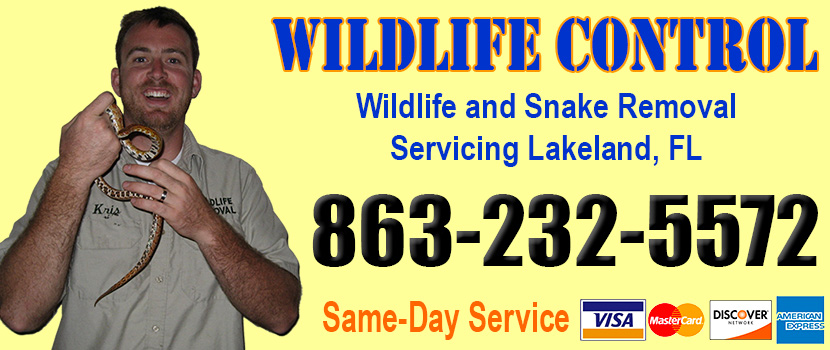
Welcome to lakelandsnakes.com! I am David, a snake enthusiast living in Lakeland, FL. Many people don't know that Lakeland is in fact full of snakes! You just need to know where to find them - they can often be shy and elusive. Some Florida snake species are more common outside of the city limits, in different parts of Polk County FL, but many types of snakes are indeed common in the more urban parts of Lakeland. This guide is meant to help educate you about the beautiful snakes of Lakeland, and to help you identify the most common snakes of Lakeland, as well as the venomous snakes of Lakeland that you should learn to recognize and avoid. If you want more detail, click here for my complete list of ALL snake species in Lakeland. Remember the following:
- Most snakes of Lakeland are harmless and don't want to encounter you
- Venomous snakes exist but are uncommon in Lakeland, Florida
- Snakes eat rats and mice and are a valuable part of the Florida ecosystem
- Never kill a snake - if you leave a snake alone, it will leave you alone.
Common Snake Species in Lakeland
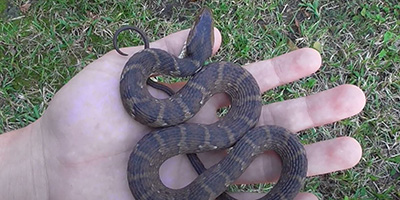 Banded Water Snake:
The water snake family poses no threat to humans. From their name, they spend most of their time in or around water.
They have colors ranging from light brown to a reddish color to black with darker crossbands that are larger on the middle of the back and narrower on the sides -which is opposite to the pattern of copperheads.
Banded water snakes are active both during the day and night but mostly stay close to the water. Sometimes, they would be on logs or branches overhanging the water.
Banded Water Snake:
The water snake family poses no threat to humans. From their name, they spend most of their time in or around water.
They have colors ranging from light brown to a reddish color to black with darker crossbands that are larger on the middle of the back and narrower on the sides -which is opposite to the pattern of copperheads.
Banded water snakes are active both during the day and night but mostly stay close to the water. Sometimes, they would be on logs or branches overhanging the water.
 Black Pine Snake:
This species is a thick-bodied non-venomous type of snake that comes with an indistinct pattern of large reddish-brown or dark tan blotches around the body -which is either tan, cream, or brownish-gray in color.
Their pattern is more distinct on the bottom parts of their body such as the hind part and the tail.
Some of them may lack the blotched pattern which causes them to appear light-colored instead, while others appear nearly black.
Although they aren’t harmful to the other beings around them, they would fight back when they encounter threats. However, they aren’t aggressive by default.
Black Pine Snake:
This species is a thick-bodied non-venomous type of snake that comes with an indistinct pattern of large reddish-brown or dark tan blotches around the body -which is either tan, cream, or brownish-gray in color.
Their pattern is more distinct on the bottom parts of their body such as the hind part and the tail.
Some of them may lack the blotched pattern which causes them to appear light-colored instead, while others appear nearly black.
Although they aren’t harmful to the other beings around them, they would fight back when they encounter threats. However, they aren’t aggressive by default.
 Brown Water Snake:
These stout-bodied snakes reach a length of up to 60 inches. In color, they are light tan with dark brown blotches down the middle of their backs. These also extend upwards from the belly to the sides of the body between the blotches on the back.
Their appearance can be comparable to that of the venomous cottonmouth particularly because of the similar coloring, habitat, and head shape.
They are non-venomous and are not dangerous to humans and animals around them as they are not normally defensive unless they are provoked.
When they are attacked, their bites can still inflict pain. Although medical attention may be needed, it isn’t too bad that it would become something fatal.
Brown Water Snake:
These stout-bodied snakes reach a length of up to 60 inches. In color, they are light tan with dark brown blotches down the middle of their backs. These also extend upwards from the belly to the sides of the body between the blotches on the back.
Their appearance can be comparable to that of the venomous cottonmouth particularly because of the similar coloring, habitat, and head shape.
They are non-venomous and are not dangerous to humans and animals around them as they are not normally defensive unless they are provoked.
When they are attacked, their bites can still inflict pain. Although medical attention may be needed, it isn’t too bad that it would become something fatal.
Venomous Snake Species in Lakeland
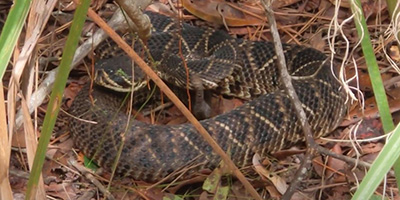 Eastern Diamondback Rattlesnake:
One of the most dangerous venomous snakes found in Florida is the diamondback rattlesnake -which is also quite large, in terms of length and body size.
They have a series of brown diamonds with yellow borders that run down its back. This is a characteristic that can help in identifying them, especially because this is quite vivid in appearance.
Because of this, despite being the most feared and dangerous in the state, they are also the easiest ones to identify among all other venomous snakes.
Most of their movement occurs during the day time, and would mostly be restricted to the morning and evening during the summer. This is because they spend winter in stump holes or tortoise burrows.
Eastern Diamondback Rattlesnake:
One of the most dangerous venomous snakes found in Florida is the diamondback rattlesnake -which is also quite large, in terms of length and body size.
They have a series of brown diamonds with yellow borders that run down its back. This is a characteristic that can help in identifying them, especially because this is quite vivid in appearance.
Because of this, despite being the most feared and dangerous in the state, they are also the easiest ones to identify among all other venomous snakes.
Most of their movement occurs during the day time, and would mostly be restricted to the morning and evening during the summer. This is because they spend winter in stump holes or tortoise burrows.
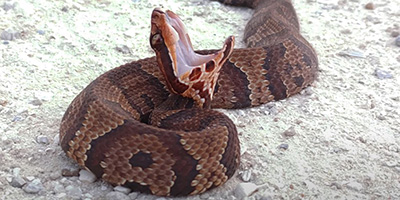 Florida Cottonmouth:
This venomous snake has a pattern of light brown and dark brown crossbands that contain scattered dark speckles. However, this pattern tends to darken with age and can potentially become a uniform black color.
Cottonmouths aren’t aggressive in most instances and would avoid direct contact with predators. Their bites are mostly caused by intentional attacks or accidents.
When they sense danger around them, they reveal the white insides of their mouth to the threat.
Florida Cottonmouth:
This venomous snake has a pattern of light brown and dark brown crossbands that contain scattered dark speckles. However, this pattern tends to darken with age and can potentially become a uniform black color.
Cottonmouths aren’t aggressive in most instances and would avoid direct contact with predators. Their bites are mostly caused by intentional attacks or accidents.
When they sense danger around them, they reveal the white insides of their mouth to the threat.
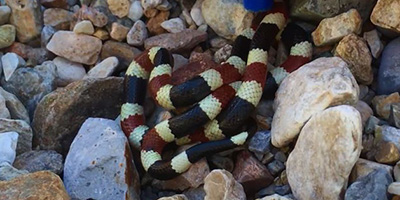 Eastern Coral Snake:
This is another member of the venomous snakes in the area.
The most obvious feature of the coral snake is its bright body pattern consisting of red, yellow, and black rings. They are also the only eastern snake species that have a pair of fixed fangs in the front of their mouth.
Coral snakes aren’t regularly seen around because of their secretive nature which causes them to spend most time underground instead.
When they are threatened, they would elevate and curl the tips of their tail.
Eastern Coral Snake:
This is another member of the venomous snakes in the area.
The most obvious feature of the coral snake is its bright body pattern consisting of red, yellow, and black rings. They are also the only eastern snake species that have a pair of fixed fangs in the front of their mouth.
Coral snakes aren’t regularly seen around because of their secretive nature which causes them to spend most time underground instead.
When they are threatened, they would elevate and curl the tips of their tail.
If you're unsure, you can email me a photo of the snake at info@lakelandsnakes.com and I will email you back with the snake's species. If you found a snake skin, read my Found a Skin? page, and you can email me a photo of the skin, and I'll identify the snake for you. If you need professional Lakeland snake removal help, click my Get Help page, or see the below website sponsor I found, who provides that service.
Remember, the term is not poisonous snakes of Lakeland, it's venomous snakes of Lakeland. Poison is generally something you eat, and venom is injected into you. That said, dangerous snakes are very rare in Lakeland. The few venomous snakes of Polk County are rarely seen. But they are commonly misidentified, so learn about all the snake species of Lakeland in order to correctly identify them. These snakes are usually also found in the surrounding towns of Lakeland, Winter Haven, Bartow, Davenport, Haines City, Lake Wales, Auburndale, Polk City, Mulberry, Frostproof, Fort Meade, Lake Alfred, Dundee, Eagle Lake, Lake Hamilton, Alturas, Highland City, Kathleen, Babson Park, Wahneta, Cypress Gardens, Lakeland Highlands, Combee Settlement, Crystal Lake, Highland Park, Loughman, Jan Phyl Village, Bradley Junction, Gibsonia, Hillcrest Heights, Fussels Corner, Inwood, and the surrounding areas.
Read our article about:
A Comprehensive Guide on Corn Snakes
lakelandsnakes.com domain and hosting costs made possible by the generous support of this sponsor:
